Kidney Failure Glossary
On this page:
This glossary defines words that are often used when people talk or write about kidney failure and its treatments. It is designed for people whose kidneys have failed and for their families and friends.
The words are listed in alphabetical order. Some words have many meanings; only those meanings that relate to kidney diseases are included. Words that appear in bold italic are defined elsewhere in the glossary. A term will refer the reader to another definition only when the second definition gives additional information about the topic that is directly related to the first term.
[Top]
A
access: In dialysis, the point on the body where a needle or catheter is inserted. (See also arteriovenous fistula, graft, and vascular access.)
acute renal (REE-nul) failure: Sudden and temporary loss of kidney function. (See also chronic kidney disease.)
allograft (AL-oh-graft): An organ or tissue transplant from one human to another.
amyloidosis (AM-ih-loy-DOH-sis): A condition in which a protein-like material builds up in one or more organs. This material cannot be broken down and interferes with the normal function of that organ. People who have been on dialysis for several years often develop amyloidosis because the artificial membranes used in dialysis fail to filter the protein-like material out of the blood.
anemia (uh-NEE-mee-uh): The condition of having too few red blood cells. Healthy red blood cells carry oxygen throughout the body. If the blood is low on red blood cells, the body does not get enough oxygen. People with anemia may be tired and pale and may feel their heartbeat change. Anemia is common in people with chronic kidney disease or those on dialysis. (See also erythropoietin.)
anuria (uh-NYOOR-ee-uh): A condition in which a person stops making urine.
arterial (ar-TEER-ee-ul) line: In hemodialysis (see dialysis), tubing that takes blood from the body to the dialyzer.
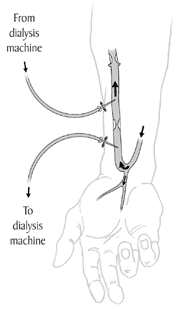
Arteriovenous fistula.
arteriovenous (ar-TEER-ee-oh-VEE-nus) (AV) fistula (FIST-yoo-lah): Surgical connection of an artery directly to a vein, usually in the forearm, created in patients who will need hemodialysis (see dialysis). The AV fistula causes the vein to grow thicker, allowing the repeated needle insertions required for hemodialysis.
artery (AR-ter-ee): A blood vessel that carries blood away from the heart to the body. (See also vein.)
artificial kidney: Another name for a dialyzer.
autoimmune (aw-toh-ih-MYOON) disease: A disease that occurs when the body’s immune system mistakenly attacks the body itself.
[Top]
B
biopsy (BY-op-see): A procedure in which a tiny piece of a body part, such as the kidney or bladder, is removed for examination under a microscope.
bladder: The balloon-shaped organ inside the pelvis that holds urine.
blood urea (yoo-REE-uh) nitrogen (NY-truh-jen) (BUN): A waste product in the blood that comes from the breakdown of food protein. The kidneys filter blood to remove urea. As kidney function decreases, the BUN level increases.
[Top]
C
catheter (KATH-eh-ter): A tube inserted through the skin into a blood vessel or cavity to draw out body fluid or infuse fluid. In peritoneal dialysis (see dialysis), a catheter is used to infuse dialysis solution into the abdominal cavity and drain it out again.
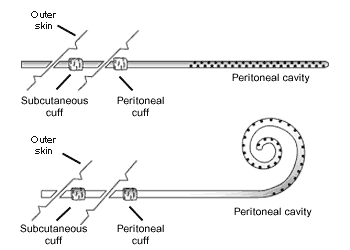
Two double-cuff Tenckhoff chronic peritoneal catheters:
standard (A), curled (B).
chronic kidney disease: Slow and progressive
loss of kidney function over several years,
often resulting in permanent kidney failure.
People with permanent kidney failure need dialysis
or transplantation (see transplant) to
replace the work of the kidneys.
creatinine (kree-AT-ih-nin): A waste product from meat protein in the diet and from the muscles of the body. Creatinine is removed from blood by the kidneys; as kidney disease progresses, the level of creatinine in the blood increases.
creatinine clearance: A test that measures how efficiently the kidneys remove creatinine and other wastes from the blood. Low creatinine clearance indicates impaired kidney function.
cross-matching: Before a transplant, the donor’s blood is tested with the recipient’s blood to see whether they are compatible.
[Top]
D
diabetes (dy-uh-BEE-teez) mellitus (MELL-ih-tus): A condition characterized by high blood glucose (sugar) resulting from the body’s inability to use glucose efficiently. Insulin normally helps the body’s cells use glucose. In type 1 diabetes, the pancreas makes little or no insulin; in type 2 diabetes, the body is resistant to the effects of available insulin.
dialysis (dy-AL-ih-sis): The process of cleaning wastes from the blood artificially. This job is normally done by the kidneys. If the kidneys fail, the blood must be cleaned artificially with special equipment. The two major forms of dialysis are hemodialysis and peritoneal dialysis.
- hemodialysis (HEE-moh-dy-AL-ih-sis):
The use of a machine to clean wastes from the blood after the
kidneys have failed. The blood
travels through tubes to a dialyzer,
which removes wastes and extra fluid. The cleaned blood then flows
through another set of tubes back into the body.
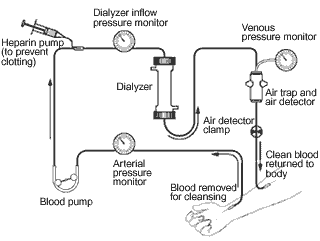
Hemodialysis.
- peritoneal (PEH-rih-tuh-NEE-ul) dialysis:
Cleaning the blood by using the lining of the abdominal cavity
as a filter. A cleansing liquid, called dialysis
solution, is drained from a bag into the abdomen.
Fluids and wastes flow through the lining of the cavity and remain
"trapped" in the dialysis solution. The solution is then drained
from the abdomen, removing the extra fluids and wastes from the
body. There are two main types of peritoneal dialysis:
- continuous ambulatory (AM-byoo-luh-TOH-ree)
peritoneal dialysis (CAPD): The most common type of peritoneal
dialysis. It needs no machine. With CAPD, the blood is always
being cleaned. The dialysis solution
passes from a plastic bag through the catheter
and into the abdomen. The solution stays in the abdomen with
the catheter sealed. After several hours, the person using CAPD
drains the solution back into a disposable bag. Then the person
refills the abdomen with fresh solution through the same catheter,
to begin the cleaning process again.
- continuous cycling peritoneal dialysis
(CCPD): A form of peritoneal dialysis that uses a machine.
This machine automatically fills and drains the dialysis
solution from the abdomen. A typical CCPD schedule
involves three to five exchanges
during the night while the person sleeps. During the day, the
person using CCPD performs one exchange with a dwell
time that lasts the entire day.
dialysis solution: A cleansing liquid used in the two major forms of dialysis—hemodialysis and peritoneal dialysis. Dialysis solution contains dextrose (a sugar) and other chemicals similar to those in the body. Dextrose draws wastes and extra fluid from the body into the dialysis solution.
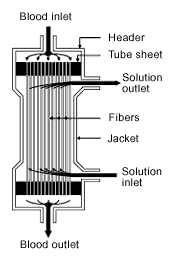
Structure of a typical hollow
fiber dialyzer.
dialyzer (DY-uh-LY-zur): A part of the hemodialysis machine. (See dialysis.) The dialyzer has two sections separated by a membrane. One section holds dialysis solution. The other holds the patient’s blood.
donor: A person who offers blood, tissue, or an organ for transplantation. (See transplant.) In kidney transplantation, the donor may be someone who has just died or someone who is still alive, usually a relative.
dry weight: The ideal weight for a person after a hemodialysis (see dialysis) treatment. The weight at which a person’s blood pressure is normal and no swelling exists because all excess fluid has been removed.
dwell time: In peritoneal dialysis (see dialysis), the amount of time a bag of dialysis solution remains in the patient’s abdominal cavity during an exchange.
[Top]
E
edema (eh-DEE-muh): Swelling caused by too much fluid in the body.
electrolytes (ee-LEK-troh-lites): Chemicals in
the body fluids that result from the breakdown of salts, including sodium,
potassium, magnesium, and chloride. The
kidneys control the amount of electrolytes
in the body. When the kidneys fail, electrolytes get out of balance, causing
potentially serious health problems. Dialysis can
correct this problem.
end-stage renal (REE-nul) disease (ESRD): Total and permanent kidney failure. When the kidneys fail, the body retains fluid and harmful wastes build up. A person with ESRD needs treatment to replace the work of the failed kidneys.
erythropoietin (eh-RITH-roh-POY-uh-tin): A hormone made by the kidneys to help form red blood cells. Lack of this hormone may lead to anemia.
ESRD: See end-stage renal
disease.
exchange: In peritoneal dialysis (see dialysis), the draining of used dialysis solution from the abdomen, followed by refilling with a fresh bag of solution.
[Top]
F
fistula (FIST-yoo-lah): See arteriovenous fistula.
[Top]
G
glomeruli (gloh-MEHR-yoo-lie): Plural of glomerulus.
glomerulonephritis (gloh-MEHR-yoo-loh-nef-RY-tis): Inflammation of the glomeruli. Most often, it is caused by an autoimmune disease, but it can also result from infection.
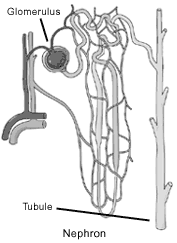
Glomerulus.
glomerulosclerosis (gloh-MEHR-yoo-loh-skleh-ROH-sis): Scarring of the glomeruli. It may result from diabetes mellitus (diabetic glomerulosclerosis) or from deposits in parts of the glomeruli (focal segmental glomerulosclerosis). The most common signs of glomerulosclerosis are proteinuria and kidney failure.
glomerulus (gloh-MEHR-yoo-lus): A tiny set of looping blood vessels in the nephron where blood is filtered in the kidney.
graft: In hemodialysis
(see dialysis), a vascular
access surgically created using a synthetic tube to
connect an artery to a vein.
In transplantation (see transplant),
a graft is the transplanted organ or tissue.
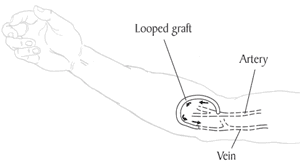
Graft.
[Top]
H
hematocrit (hee-MAT-uh-krit): A measure that tells what portion of a blood sample consists of red blood cells. Low hematocrit suggests anemia or massive blood loss.
hematuria (HEE-muh-TOO-ree-uh): A condition in which urine contains blood or red blood cells.
hemodialysis: See dialysis.
hormone: A natural chemical produced in one part of the body and released into the blood to trigger or regulate particular functions of the body. The kidney releases three hormones: erythropoietin, renin, and an active form of vitamin D that helps regulate calcium for bones.
hypertension (HY-per-TEN-shun): High blood pressure, which can be caused either by too much fluid in the blood vessels or by narrowing of the blood vessels.
[Top]
I
immune (ih-MYOON) system: The body’s system for protecting itself from viruses and bacteria or any “foreign” substances.
immunosuppressant (ih-MYOON-oh-suh-PRESS-unt): A drug given to suppress the natural responses of the body’s immune system. Immunosuppressants are given to transplant patients to prevent organ rejection and to patients with autoimmune diseases like lupus.
interstitial (IN-ter-STISH-ul) nephritis (nef-RY-tis): Inflammation of the kidney cells that are not part of the fluid-collecting units, a condition that can lead to acute renal failure or chronic kidney disease.
intravenous (IN-truh-VEE-nus) pyelogram (PY-loh-gram): An x ray of the urinary tract. A dye is injected to make the kidneys, ureters, and bladder visible on the x ray and show any blockage in the urinary tract.
[Top]
K
kidney: One of two bean-shaped organs that filter wastes from the blood. The kidneys are located near the middle of the back. They create urine, which is delivered to the bladder through tubes called ureters.
kidney failure: Loss of kidney function. (See also end-stage renal disease, acute renal failure, and chronic kidney disease.)
Kt/V (kay-tee over vee): A measurement of dialysis dose. The measurement takes into account the efficiency of the dialyzer, the treatment time, and the total volume of urea in the body. (See also URR.)
[Top]
M
membrane: A thin sheet or layer of tissue that lines a cavity or separates two parts of the body. A membrane can act as a filter, allowing some particles to pass from one part of the body to another while keeping others where they are. The artificial membrane in a dialyzer filters waste products from the blood.
membranoproliferative (MEM-bray-no-pro-LIF-er-uh-tiv) glomerulonephritis (gloh-MEHR-yoo-loh-nef-RY-tis): A disease that occurs primarily in children and young adults. Over time, inflammation leads to scarring in the glomeruli, causing proteinuria, hematuria, and sometimes chronic kidney disease or end-stage renal disease.
[Top]
N
nephrectomy (nef-REK-tuh-mee): Surgical removal of a kidney.
nephrologist (nef-RAHL-oh-jist): A doctor who treats patients with kidney problems or hypertension.
nephron (NEF-rahn): A tiny part of the kidneys. Each kidney is made up of about 1 million nephrons, which are the working units of the kidneys, removing wastes and extra fluids from the blood.
nephrotic (nef-RAH-tik) syndrome: A collection of symptoms that indicate kidney damage. Symptoms include high levels of protein in the urine, lack of protein in the blood, and high blood cholesterol.
nuclear (NEW-klee-ur) scan: A test of the structure, blood flow, and function of the kidneys. The doctor injects a mildly radioactive solution into an arm vein and uses x rays to monitor its progress through the kidneys.
[Top]
P
peritoneal (PEH-rih-tuh-NEE-ul) cavity: The space inside the lower abdomen but outside the internal organs.
peritoneal dialysis: See dialysis.
peritoneum (PEH-rih-tuh-NEE-um): The membrane lining the peritoneal cavity.
peritonitis (PEH-rih-tuh-NY-tis): Inflammation of the peritoneum, a common complication of peritoneal dialysis (see dialysis).
potassium (puh-TASS-ee-um): A mineral found in the body and in many foods.
proteinuria (PRO-tee-NOOR-ee-uh): A condition in which the urine contains large amounts of protein, a sign that the kidneys are not functioning properly.
[Top]
R
renal (REE-nul): Of the kidneys. A renal disease is a disease of the kidneys. Renal failure means the kidneys have stopped working properly.
renal osteodystrophy (AH-stee-oh-DIS-truh-fee): Weak bones caused by poorly working kidneys. Renal osteodystrophy is a common problem for people on dialysis who have high phosphate levels or insufficient vitamin D supplementation.
renin (REE-nin): A hormone made by the kidneys that helps regulate the volume of fluid in the body and blood pressure.
[Top]
S
sodium (SOH-dee-um): A mineral found in the body and in many foods.
[Top]
T
thrill: A vibration or buzz that can be felt in an arteriovenous fistula, an indication that the fistula is healthy.
transplant: Replacement of a diseased organ with a healthy one. A kidney transplant may come from a living donor, usually a relative, or from someone who has just died.
[Top]
U
urea (yoo-REE-uh): A waste product found in the blood and caused by the normal breakdown of protein in the liver. Urea is normally removed from the blood by the kidneys and then excreted in the urine. Urea accumulates in the body of people with renal failure.
uremia (yoo-REE-mee-uh): The illness associated with the buildup of urea in the blood because the kidneys are not working effectively. Symptoms include nausea, vomiting, loss of appetite, weakness, and mental confusion.
ureters (YOOR-uh-turs): Tubes that carry urine from the kidneys to the bladder.
urethra (yoo-REE-thrah): The tube that carries urine from the bladder to the outside of the body.
urinalysis (yoor-in-AL-ih-sis): A test of a urine sample that can reveal many problems of the urinary system and other body systems. The sample may be observed for color, cloudiness, and concentration; signs of drug use; chemical composition, including sugar; the presence of protein, blood cells, or germs; or other signs of disease.
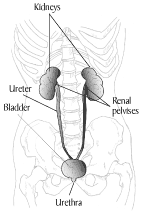
Urinary tract.
urinary (YOOR-ih-NEHR-ee) tract: The system that takes wastes from the blood and carries them out of the body in the form of urine. The urinary tract includes the kidneys, renal pelvises, ureters, bladder, and urethra.
urinate (YOOR-ih-nate): To release urine from the bladder to the outside.
urine (YOOR-in): Liquid waste product filtered from the blood by the kidneys, stored in the bladder, and expelled from the body through the urethra by the act of voiding or urinating. (See also urinate.)
URR (urea reduction ratio): A blood test that compares the amount of blood urea nitrogen before and after dialysis to measure the effectiveness of the dialysis dose.
[Top]
V
vascular (VASS-kyoo-lur) access: A general term to describe the area on the body where blood is drawn for circulation through a hemodialysis (see dialysis) circuit. A vascular access may be an arteriovenous fistula, a graft, or a catheter.
vein (VANE): A blood vessel that carries blood toward the heart.
venous (VEE-nus) line: In hemodialysis (see dialysis), tubing that carries blood from the dialyzer back to the body.
[Top]
About the Kidney Failure Series
You and your doctor will work together to choose a treatment that’s best for you. The publications of the NIDDK Kidney Failure Series can help you learn about the specific issues you will face.
Booklets
Fact Sheets
Learning as much as you can about your treatment will help make you an important member of your health care team.
NIDDK will develop additional materials for this series as needed. Please address any comments about this series and requests for copies to the National Kidney and Urologic Diseases Information Clearinghouse. Descriptions of the publications in this series are available at http://kidney.niddk.nih.gov/kudiseases/pubs/kidneyfailure/index.htm on the Internet.
[Top]
National Kidney and Urologic Diseases Information Clearinghouse
3 Information Way
Bethesda, MD 20892–3580
Phone: 1–800–891–5390
TTY: 1–866–569–1162
Fax: 703–738–4929
Email: nkudic@info.niddk.nih.gov
Internet: www.kidney.niddk.nih.gov
The National Kidney and Urologic Diseases Information Clearinghouse (NKUDIC) is a service of the National Institute of Diabetes and Digestive and Kidney Diseases (NIDDK). The NIDDK is part of the National Institutes of Health of the U.S. Department of Health and Human Services. Established in 1987, the Clearinghouse provides information about diseases of the kidneys and urologic system to people with kidney and urologic disorders and to their families, health care professionals, and the public. The NKUDIC answers inquiries, develops and distributes publications, and works closely with professional and patient organizations and Government agencies to coordinate resources about kidney and urologic diseases.
Publications produced by the Clearinghouse are carefully reviewed by both NIDDK scientists and outside experts.
This publication is not copyrighted. The Clearinghouse encourages users of this publication to duplicate and distribute as many copies as desired.
NIH Publication No. 03–4894
April 2003
[Top]
|






